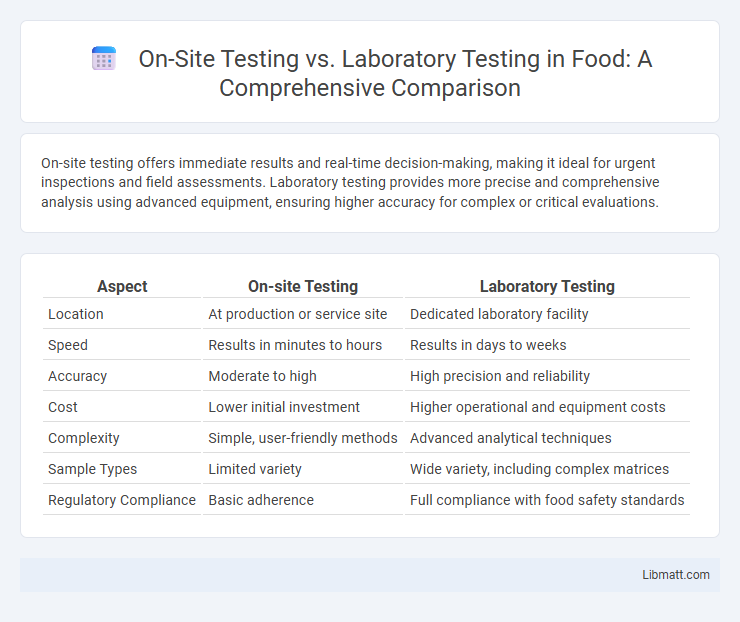On-site testing offers immediate results and real-time decision-making, making it ideal for urgent inspections and field assessments. Laboratory testing provides more precise and comprehensive analysis using advanced equipment, ensuring higher accuracy for complex or critical evaluations.
Table of Comparison
| Aspect | On-site Testing | Laboratory Testing |
|---|---|---|
| Location | At production or service site | Dedicated laboratory facility |
| Speed | Results in minutes to hours | Results in days to weeks |
| Accuracy | Moderate to high | High precision and reliability |
| Cost | Lower initial investment | Higher operational and equipment costs |
| Complexity | Simple, user-friendly methods | Advanced analytical techniques |
| Sample Types | Limited variety | Wide variety, including complex matrices |
| Regulatory Compliance | Basic adherence | Full compliance with food safety standards |
Introduction to On-Site and Laboratory Testing
On-site testing enables immediate data collection and analysis directly at the location where materials or products are used, providing rapid feedback for quality control and troubleshooting. Laboratory testing involves controlled environments with specialized equipment and trained personnel, yielding highly precise and comprehensive results for complex analyses. Choosing between on-site and laboratory testing depends on your need for speed, accuracy, and the specific parameters being measured.
Key Differences Between On-Site and Laboratory Testing
On-site testing delivers immediate results by analyzing samples directly at the location, ideal for time-sensitive decisions and operational adjustments. Laboratory testing offers higher accuracy and comprehensive analysis through controlled environments and advanced equipment, suitable for detailed diagnostics and regulatory compliance. Your choice depends on the need for speed versus precision, with on-site testing prioritizing convenience and laboratory testing emphasizing thoroughness.
Advantages of On-Site Testing
On-site testing offers the advantage of immediate results, enabling faster decision-making and reducing downtime in critical operations. It eliminates sample transportation risks and costs, ensuring data accuracy by analyzing materials in their actual environment. Your ability to promptly address issues on-site improves operational efficiency and supports real-time troubleshooting.
Limitations of On-Site Testing
On-site testing often faces limitations such as reduced accuracy compared to laboratory testing due to environmental factors and limited equipment sensitivity. Sample contamination risk increases with on-site procedures, potentially compromising results. Your decision should weigh the convenience of immediate results against these constraints to ensure data reliability.
Benefits of Laboratory Testing
Laboratory testing offers precise and controlled conditions, ensuring accurate and reliable results that on-site testing may not achieve. Advanced equipment and standardized protocols in laboratories enable detailed analysis of complex samples, providing comprehensive data critical for informed decision-making. Your choice of laboratory testing enhances the credibility and validity of findings, especially for regulatory compliance and quality assurance purposes.
Drawbacks of Laboratory Testing
Laboratory testing often involves longer turnaround times due to sample transportation and processing delays, which can hinder timely decision-making in critical situations. The controlled environment of a lab may not accurately replicate real-world conditions, potentially leading to less relevant or less actionable results. High operational costs and the need for specialized equipment and trained personnel further limit the accessibility and scalability of laboratory testing compared to on-site alternatives.
Cost Comparison: On-Site vs Laboratory Testing
On-site testing typically incurs lower costs by eliminating sample transportation and reducing turnaround times, making it more budget-friendly for immediate results. Laboratory testing, while often more expensive due to equipment, personnel expertise, and facility overheads, provides higher accuracy and comprehensive analysis. Your choice depends on balancing cost-efficiency with the depth and precision of testing required.
Accuracy and Reliability: Head-to-Head Analysis
On-site testing offers rapid results but may sacrifice some accuracy and reliability due to environmental variables and limited equipment compared to controlled laboratory testing. Laboratory testing provides highly accurate and reliable data through standardized protocols, advanced instrumentation, and skilled analysts, ensuring consistent quality control. Your choice depends on the critical need for precise data versus the advantage of immediate insights in field conditions.
Choosing the Right Method for Your Industry
On-site testing provides immediate results and real-time data crucial for industries requiring quick decision-making, such as construction and environmental monitoring. Laboratory testing offers higher accuracy and comprehensive analysis, making it ideal for pharmaceuticals, food safety, and quality control sectors. Evaluating your industry's priorities for speed, precision, and regulatory compliance helps determine the optimal testing method.
Future Trends in On-Site and Laboratory Testing
Future trends in on-site and laboratory testing emphasize rapid, accurate diagnostics through advanced technologies like AI-driven analyzers and portable molecular testing devices. Integration of IoT and cloud computing enhances data sharing and real-time monitoring, improving decision-making in various industries. Your ability to leverage these innovations ensures streamlined workflows and more precise, timely results in quality control and environmental assessments.
on-site testing vs laboratory testing Infographic

 libmatt.com
libmatt.com